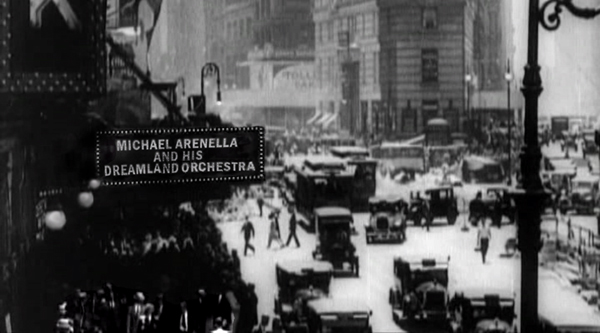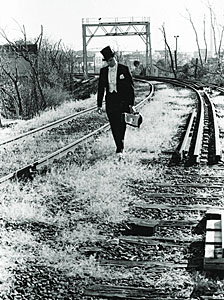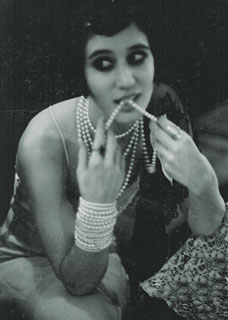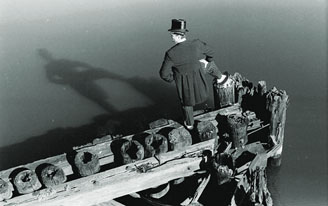The Roaring Twenties
Written by Michael Arenella

The Pulse Of An Age
A gleaming locomotive blows through a small town, changing it forever.
It's the 1920s, and the rails are humming.
 The clickety-clack whisks you through slumbering towns on the cusp of a modern dawn. Trackside, hammers and rivets clinking in tandem with the pounding of shipyards and factories, bending and forging.
Leagues of pistons and presses, all beating out a hypnotic rhythm. Sparking ore is poured into beams, ever climbing, redefining the horizon with towers of speculation and promise.
The clickety-clack whisks you through slumbering towns on the cusp of a modern dawn. Trackside, hammers and rivets clinking in tandem with the pounding of shipyards and factories, bending and forging.
Leagues of pistons and presses, all beating out a hypnotic rhythm. Sparking ore is poured into beams, ever climbing, redefining the horizon with towers of speculation and promise.
And in the gloaming, as streetlamps are lighted, let us step off from the thoroughfare; downstairs to a place where one would go to escape the clamour of the day. A place lost in a cloud of perfumed smoke, where rouged lips and cold gin speak of softer things. Here, the rhythm of the outside world is hushed; re-emerges as something human. Still pulsing, but warmer:
A trio of clarinets are the shrill cry of the whistle. A cornet's clarion tone pierces the dark like a headlight. The plumes of steam are the breathy saxophones. Steel wheels clanking at the rail joints are the choke-cymbal. Trailing behind, a trombone enshrouds us in hazy smoke. And in the corner with his back to us, the pianist’s fingers reach for the blue horizon beyond.
The Flaming Youth

The enforcement of Prohibition only serves to heighten the excitement of pleasure seeking. One is practically breaking the law just by "going out", and this adds to the allure and decadence of nightlife. A realm of escape hatches and hidden corridors creates a world of illusion, glamour, and anoniminity.
In the boudoir, corsets and petticoats are packed into storage, as are most societal and moral taboos. For young Flappers, the gender line becomes blurred with the introduction of the androgenous "garcon" look. Curves are concealed, and long locks sheared for boyish bobs. Silk hose will be provocatively rolled down towards the knee. Hip flasks are tucked under a garter, as independent gals set out for a night of hot jazzing.
Suddenly, a young lady is following her own whim and fancy, and with this new attitude, the "weaker sex" takes charge. Luminaries such as Clara Bow, Louise Brooks, and Marlene Dietrich become symbols of the new, liberated girl, unashamed of their own pursuit of whimsy and pleasure.
Similarly, with young men, the shadow of the Great War looms in the not-so-distant past, and it is time to live for the day. This brush with mortality gives many a new lease on life, and couples dance each dance as if there will not be another.
A sense of freedom and wanderlust is also spreading: As automobiles become more affordable, the call of the open road leads to a newfound mobility and independence. This literally paves the way for the adventures of young lovers, who will find themselves in complete privacy within a short, bumpy ride!
These are the times of the "Flaming Youth", and the world is their oyster.

Further Historical Context
From an interview with Michael Arenella:
Who were these young people who danced to and played this music?
 You had all these kids who grew up in St. Joe or Peoria, and farm towns, and they suddenly moved to big cities - Chicago or New York — 1920 was the first time in American history when more people lived in cities than in the country. Suddenly they’re flapper girls, but they were farm girls at heart. And the young men; many came from these towns where they were farmers, or yard hands, or laborers, and the whole culture around this music has this essence of modesty, and people were still old-fashioned. There was a sweetness, an innocence to the youth; few were jaded because everyone came from humble places. And then they move to this exciting urban speed. It was really just as simple as that: Old-World simplicity comes to the city and gets a new wardrobe.
You had all these kids who grew up in St. Joe or Peoria, and farm towns, and they suddenly moved to big cities - Chicago or New York — 1920 was the first time in American history when more people lived in cities than in the country. Suddenly they’re flapper girls, but they were farm girls at heart. And the young men; many came from these towns where they were farmers, or yard hands, or laborers, and the whole culture around this music has this essence of modesty, and people were still old-fashioned. There was a sweetness, an innocence to the youth; few were jaded because everyone came from humble places. And then they move to this exciting urban speed. It was really just as simple as that: Old-World simplicity comes to the city and gets a new wardrobe.
Talk a bit more about the role of trains in this music.
Trains are what built America. Most towns that exist were built by the railroads, so the backbone of America is the railroad. So you have this pulsing rhythm in America’s subconscious — the rhythm of the train. If you listen to an old steam locomotive, you can dance to it. It swings. And you hear it in the music. Jazz from that era sounds like a train, or a factory. I find that noise to be quite lovely.